“The role of the teacher-librarian as an educator who works collaboratively with other teachers to create and sustain powerful and relevant learning experiences for students made it essential to focus on literacy cognitive abilities and foundational skills for educating BC children today. Teacher-librarians support both teachers and students as they explore multiple sources of information to create new knowledge and learning.” (The Points of Inquiry, 2011)
The collaborative role that a teacher-librarian implements in the learning commons is the framework that enables inquiry to develop. Each teacher’s interaction with the learning commons differs specifically with their approach to inquiry and more broadly in relation to library use: from social studies research based projects, to English booktopias to Math LEGO area and design activities. Essentially the learning commons in 2020 differs heavily from libraries in schools 20+ years ago and how classroom teachers interact with the learning commons has also been reshaped as changes evolve. Digital learning technologies have progressed and traditional approaches to research and curriculum have been updated. In order to shape a library program and build a learning commons, the teacher-librarian’s role and tools of support need to be shared within the school community. The goal is getting as much use in the library as possible, and utilizing the many resources available. This requires approachability and encouraging teachers to come into the space, but it also challenges teachers to approach learning differently, especially if new resources and technologies are being introduced.
Through using Concerns-Based Adoption Model, CBAM as a conceptual framework that “acknowledges that learning brings change, and supporting people in charge is critical for learning to ‘take hold’” (Loucks-Horsley, 2015) teacher-librarians are able to recognize the process of change and support teachers effectively as they evolve through the steps of change. The Concerns-Based Adoption Model was created in the 1970s and 1980s by a team of researchers at the University of Texas. To ensure its accuracy, it was further updated in 2006. “The three diagnostic dimensions of the Concerns-Based Adoption Model (CBAM) provide tools and techniques that enable leaders to gauge staff concerns and program use in order to give each person the necessary supports to ensure success.” (CBAM: The Concerns-Based Adoption Model, 2015)
The three diagnostic dimensions:
- Stages of Concern
- Levels of Use
- Innovation Configuration
“The Standards of practice for school library learning commons in Canada are framed around five core standards of practice that put school libraries at the centre of school improvement.” (Canadian School Libraries, 2018) Through collaborating with teachers, and implementing effective use of reference resources in their pedagogical practices, the understanding of the concerns-based adoption model and the diagnostic dimensions within it, can help to shape the approach to change.
Example 1 – CBAM (Stages of Concern)

- Teacher A: Ms. Callidus
- Subject Area: Social Studies 8-10
- Experience: First-year teacher. Started mid-year to replace a teacher on leave.
Ms. Callidus joined the school in February. During her first week, she was given a tour of the school and introduced to the learning commons where she was shown various resources and the booking procedures. Ms. Callidus was very enthusiastic about the space and demonstrated interest in learning more about the learning commons and how her social studies classes could utilize the space. I sent Ms. Callidus a follow up email one week after our initial meeting to invite her back to the learning commons. For this meeting, I explained that I am happy to discuss upcoming units she has with her that she might like to use the learning commons for. I have already developed resources that I’ve collaborated on with the teacher she is replacing, but also I am happy to develop new material with her as well. My goal was to engage Ms. Callidus by demonstrating approachability and encouraging collaboration. We arranged a mutually good time to meet during her prep.
This first meeting was in the learning commons office and is a cleared calm space with comfortable seating for teachers. Ms. Callidus came prepared with some research tasks to discuss, and I determined we were at the stage where a reference interview could be conducted. Following, Riedling’s guidelines, the reference interview took place in a “relatively quiet, comfortable setting that is free of clutter.” (Riedling, pg 91). Today I planned to conduct the first three stages of Rielding’s suggested practice for the reference interview as outlined in Figure 9.1.
Upon interviewing Ms. Callidus, she had a clear research assignment on revolutions for her students. Together we narrowed the students’ research query and identified reference expectations. I sensed that Ms. Callidus was looking to have me pull resources for students and prepare a cart that they could work from. This was of course, the approach she’d observed herself as a student. My goal was to stretch Ms. Callidus’s preconceived ideas of the teacher-librarian/classroom teacher support. Sure I could prepare a cart for Ms. Callidus, but I also could do much more to support her and the students research queries. This was where I pulled some past examples that showed similar structured assignments. I then showed Ms. Callidus examples of library support through note-taking templates devised for google classroom, power points and the various database options. I wanted to reassure Ms. Callidus, we have supported similar types of assignments in the learning commons and the various ways we could extend student learning together.
I could see the moment Ms. Callidus entered the stages of concern dimension the CBAM. The first three of seven stages presented themselves in this interview. (Loucks-Horsely, 2015) Ms. Callidus asked: what are these additional support resources? How do they work? How does it apply to my assignment? The subtext within these questions were: I am unsure about these new support resources. I have never used them before. They look interesting, but will they work for me. How can I use them efficiently. I am unsure.
I addressed Ms. Callidus’s concerns and explained that we can still pull books as per the original vision of the assignment, but that I am happy to prepare a power point presentation that will teach students other reference options for their query and review primary and secondary reference definitions with the students. I further explained that the note-taking document is optional and that as I have templates on hand, it is easy for me to tailor one to her assignment which she may choose to use if it seems efficient. This was the part to the reference interview where I needed to search and inform Ms. Callidus of progress.
Ms. Callidus circled back a few days later and I was able to show her the various resources pulled and tabbed. The prepared note-taking sheet and power-point presentation helped Ms. Callidus feel at ease and excited once again about the assignment.
The library lessons with Ms. Callidus’s class showed her moving up the stages of concern. How can I master and fit it all in? Is it working? Once the lessons wrapped, Ms. Callidus felt success with her project and was at the point of refocusing. She said, ‘next time we do this, let’s start with …’ This felt successful for both of us as collaborators as we discussed doing the task again in future, but also we learned and refined based on practical observation and implementation of the lesson. Ms. Callidus, has scheduled many more learning commons visits since and has changed her approach to using the library program and thereby moved within the CBAM to the “Levels of Use” dimension.
Example 2 – CBAM (Levels of Use)

- Teacher: Mr. Pertinax
- Subject Area: English 8-12
- Experience: 22-year teacher at this school.
Mr. Pertinax regularly uses the learning commons with his classes. He participates in read-ins, supports booktopias and author presentations. Mr. Pertinax is certainly a supporter of the learning commons, he, however, does not participate much in the way of collaboration and is a self-proclaimed technophobe, who proudly uses a flip phone circa 2005. His library usage is predictable and hasn’t changed much from when I started at the school 5 years ago.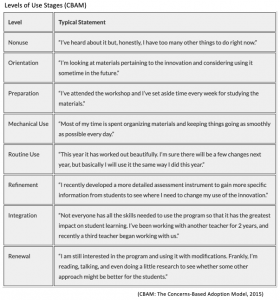
I have been trying strategies to engage Mr. Pertinax with collaboration for the past two years. From sharing of resource information at department meetings to ‘What’s New?’ updates and the informal gatherings we have in the learning commons with staff each year. When Mr. Pertinax came in to book a read-in session for his Grade 8s, I had just received a Legacy Schools box for the Downie-Wenjack Fund. Mr. Pertinax was intrigued by the box and I happily showed him one of the latest resources to support Indigenous topics within the classroom. Mr. Pertinax was excited to learn more as this is a topical area newer to him with the recently revised Learning Standards. After discussing the resources in detail, Mr. Pertinax and I arranged to meet during his prep to formulate a plan to integrate some of the Legacy lesson ideas in the library, with a specific intention of technology inclusion.
The levels of use stage of the CBAM enables the teacher-librarian to evaluate the usage of the program. (CBAM: The Concerns-Based Adoption Model, 2015) For teachers who have moved past the stages of concern and are actively using the library program, where the level of usage is at needs to be understood to help the progression of change for the classroom teacher. In the case of Mr. Pertinax, though he exhibits routine use of the learning commons space, he does not exhibit routine use of the program.
I utilized my time with Mr. Pertinax to interview his level of use. After a short interview similar to the a reference interview, Mr. Pertinax is at the orientation stage of the CBAM dimension levels of use. He referenced colleague’s library program use, which was at the integration stage of the CBAM levels of use and it seemed clear that Mr. Pertinax was ready to engage more with the program. He observed from his colleagues the ease of program usage with teacher-librarian support. Currently, Mr Pertinax demonstrates the following characteristics of the orientation stage:
- a general interest
- would like to know more
- takes initiative to learn more (Huang, n.d.)
In our subsequent meeting, we determined a research assignment on Indigenous issues in Canada focusing on the topics: 60s scoop and Residential Schools. The entire lesson is designed through google classroom and research exclusively through the use of Curio, Gale’s Global Issues In Context Canada and CBC News. We discussed the selected video clips I chose from Curio’s Secret Path Collection to integrate with the lesson.
Mr. Pertinax’s lesson at the library was engaging for his students, who were able to interact with technology more than they have in lesson thus far. Mr. Pertinax was able to see his students’ knowledge with technology, though vaster than his, was not an obstacle for his lesson. He was able to manage students and resources effectively, but was impressed by the students’ level of engagement with the task. Mr. Pertinax left the learning commons after his lesson with a sense of accomplishment and is ready to discuss another class project. Mr. Pertinax has moved up the CBAM level of use scale and is set to become a regular user of more than just the space but rather the program.
“Change is a process and not an event” (Loucks-Horsley, 2015)
When learning new approaches to learning the act of change involves acquiring new skills, but also relies on the adjustment of attitudes and beliefs. (CBAM: The Concerns-Based Adoption Model, 2015) Further, according to Loucks-Horsley, she states that changes in classroom practices are not singular events but rather occur over a three to five years before they are fully in place. The CBAM model can be implemented effectively in the library when working with all teachers but the recognition that teachers will likely be at different levels within the diagnostic dimensions. Even as the teaching profiles vary from beginning teacher to experienced, teachers who are continually adopting new curricular implementation challenges, whether this is utilizing new resources, strategies or learning models. For the library program to be successful, the end goal requires steady teacher-librarian collaborative support to help classroom teachers evolve on the CBAM scale and to ultimately achieve school-wide implementation of the program.
The teacher-librarian is “the one person on staff whose prime function is to support teachers in unit planning and lesson delivery. Teacher-librarians are committed to collaboration. We work best when we work closely with individual teachers in the critical areas of designing authentic learning tasks and integrating the research and technological pieces required by various IRPs.” (Lindsay, 2005)
Works Cited:
BCTLA Info Lit Task Force. (2011). The Points of Inquiry: A Framework for Information Literacy and the 21st century Learner. [Poster] British Columbia Teacher-Librarians Association. Retrieved March 4, 2020 from https://bctla.ca/wp-content/uploads/2018/02/the-points-of-inquiry.pdf.
Canadian School Libraries (CSL) (2018) “Leading Learning: Standards of Practice for School Library Learning Commons in Canada.” Retrieved March 5, 2020 from http://llsop.canadianschoollibraries.ca
CBAM: The Concerns-Based Adoption Model. (2015, December 8). Retrieved March 5, 2020, from American Institute For Research website: https://www.air.org/resource/cbam-concerns-based-adoption-model
Glazer, Gwen. [Photograph]. (2017 ). Finding A Book When You’ve Forgotten Its Title. Retrieved March 7, 2020 from https://www.nypl.org/blog/2017/11/22/finding-book-forgotten-title
Huang, P. (n.d) Concerns-Based Adoption Model: Levels of Use. Retrieved March 7, 2020 from https://sites.google.com/site/ch7cbam/home/levels-of-use
Lindsay, K. (2005, September). Put A Teacher-Librarian On Your Team. Teacher, 18(1), 7. Retrieved March 7, 2020 from https://www.bctf.ca/WorkArea/GetAsset.aspx?id=49643
Loucks-Horsley, Susan. (2015) “The Concerns-Based Adoption Model (CBAM): A Model for Change in Individuals”. National Standards and the Science Curriculum (ed. Rodger Bybee). Iowa: Kendall/Hunt Publishing. Retrieved March 3, 2020 from https://s3.wp.wsu.edu/uploads/sites/731/2015/07/CBAM-explanation.pdf
MacKenzie, T. (2019). Classroom Inquiry’s Secret Weapon: The Teacher-Librarian. Canadian School Libraries Journal, 3(1). Retrieved March 5, 2020 from http://journal.canadianschoollibraries.ca/classroom-inquirys-secret-weapon-the-teacher-librarian/
“Reference Interviews” [Photograph]. (n.d). Retrieved March 5, 2020 from https://ic.softlinkint.com/blog/reference-interviews-time-and-cost-expensive-or-not/
Riedling, A. M., & Houston, C. (2019). Reference skills for the school librarian: Tools and tips (4th ed.). Santa Barbara, CA: Libraries Unlimited, an imprint of ABC CLIO.

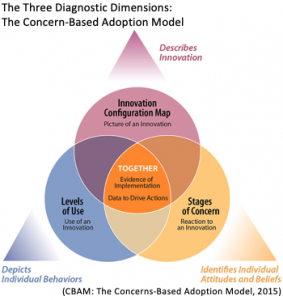
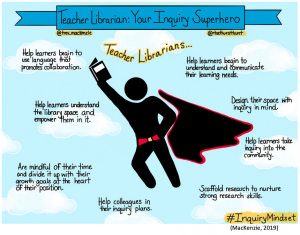
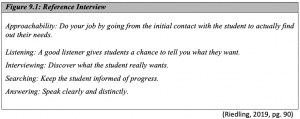
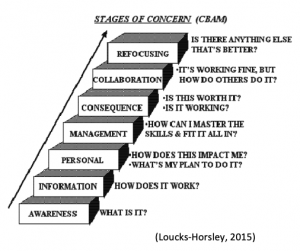
 Follow
Follow
Great post. I could really identify with your first example – Ms. Callidus. I have several times been the “replacement” teacher having come into a school mid-year. There is always a certain amount of apprehension when in this position. When you’re the “new” teacher, you’re excited to start, but as the saying goes “you don’t know what you don’t know.” Ms. Callidus thought she knew just how to begin and was likely taken aback when the TL suggested she try something different. You don’t want to come across as being inexperienced or ill-prepared, so you are hesitant to take suggestions from anyone, even the TL. I could really put myself in her shoes and could feel the weight come off my shoulders when you suggest that YOU will present a Powerpoint to the students to show them different types of resources that they may use and the difference between primary and secondary sources. Meeting with a teacher and showing them exactly how you can support them and their students is exactly what teachers need to put their minds at ease when trying something new.
There are many teachers not unlike Ms. Callidus. Many teachers don’t seem to know just how much the teacher-librarian can offer and I think this is why some teachers are hesitant to work with the TL. I like how the TL in your example offered to present a power point, personalised template and note-taking document but was still open to sticking to the teacher’s original methods if necessary.